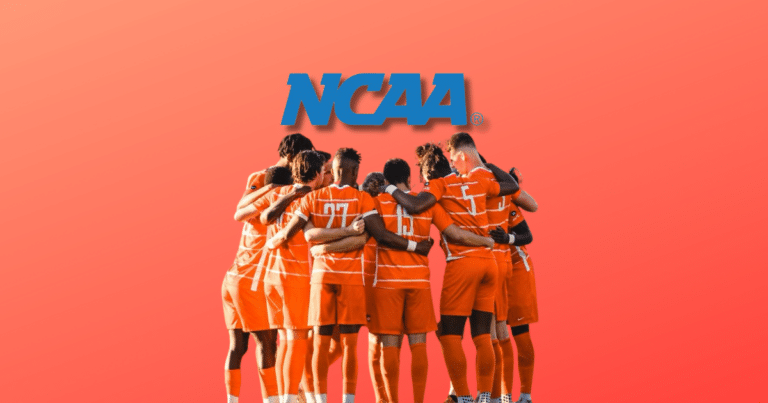Your Guide to College Soccer in the U.S.
College soccer is a big jump from club and high school soccer in the U.S. The game not only gets faster and physical but the everyday demands require players to put in more hours.
 College soccer is a highly competitive level of soccer, and only the best players in the nation make it to NCAA Division I.
College soccer is a highly competitive level of soccer, and only the best players in the nation make it to NCAA Division I.
However, the level of competition is not confined to the teams seen only on television; rather, there’s Division II and Division III soccer as well.
In this guide, we’ll explore five divisions for you to consider when looking into which path to take. They include:
- NCAA Division I
- NCAA Division II
- NCAA Division III
- NAIA
- Junior College (Juco or JC)
Are You Ready for College Soccer?
When comparing high school and club soccer to college soccer, many parents and players simply look at the talents displayed on the pitch. There’s a lot more to it than that. Colleges are looking for all-around student athletes.
In addition to talent and skills on the field, colleges want players with great attitudes and solid academics. They are investing in their program by betting that you (as the player) will help the team grow for multiple years.
Additionally, although most of the basic rules remain the same, there is an increase in match length which can be an adjustment for some players. The length of a typical high school soccer game is 80 minutes, whereas college matches are 90.
Developing the stamina to play for extended minutes is crucial in the success of a college soccer player.
College Soccer Landscape in the U.S.
Those interested in pursuing soccer at the collegiate level have a number of options:
- 205 men’s teams and 333 women’s teams compete in NCAA Division I Soccer
- 206 men’s teams and 250 women’s teams compete in NCAA Division II Soccer
- 415 men’s teams and 441 women’s teams compete in NCAA Division III Soccer
- 218 men’s teams and 223 women’s teams compete in NAIA Soccer
- 217 men’s teams and 181 women’s teams compete in Junior College Soccer
Only around 5.6% of the 460,000 students participating in high school soccer make it to the NCAA level.
College Scholarship Opportunities
Receiving an athletic scholarship is a remarkable recognition and can help finance a player’s education. These scholarships can cover all or a portion of a student’s tuition. Different divisions of college soccer and genders have different scholarship policies.
Most scholarship agreements last one year and must be renewed each year. Scholarships can also be taken away if the student-athlete fails to meet certain performance, educational and behavior requirements.
Scholarships for men’s Division I soccer schools are capped at nine, while women’s Division I teams can award up to fourteen.
Overview of College Soccer
NCAA
NCAA Division I
Division I soccer is the highest level of college soccer in the United States. It is governed by the National Collegiate Athletic Association (NCAA) and consists of approximately 205 men’s teams and 333 women’s teams across the country.
The ultimate goal of most high-caliber high school soccer players is to play at the D1 level. With that said, the percentage of males expected to play Division I college soccer is 1.3%, while the percentage of women is 2.4%, according to the NCAA. As you can see, the chances of playing at the highest collegiate level are slim.
Some of the best DI soccer programs include:
- University of North Carolina (UNC)
- Stanford
- Wake Forest
- Indiana
- Maryland
- Georgetown
- Clemson
- Virginia
- Notre Dame
- University of California, Los Angeles (UCLA)
NCAA Division II
Division II men’s soccer provides student-athletes with the fortunate opportunity to compete at a high level of competition, while also offering a more balanced experience that places a greater emphasis on academic pursuits.
This level of competition is well-suited for student-athletes who want to pursue both their athletic and academic goals, as well as for those who may not have the same level of skill or experience as Division I players.
Some of the most notable D II soccer programs include:
- California State Polytechnic University – Pomona
- Colorado School of Mines
- Bentley University
- Western Washington University
- Cedarville University
- Florida Southern College
- West Chester University of Pennsylvania
- Point Loma Nazarene University
- Rollins College
- Rockhurst University
NCAA Division III
The largest number of schools—441 for women and 415 for men—are in Division III soccer programs.
Division III men’s soccer provides student-athletes with the opportunity to participate in competitive college soccer while emphasizing more student experiences.
Unlike Division I and II soccer, there are no athletic scholarships offered at the Division III level, and student-athletes must pay for their own tuition and expenses. However, many schools do provide merits, academic scholarships or need-based financial assistance to help cover a portion of tuition.
If you are a high school athlete looking to enjoy the college experience while playing the game you love, Division III may be the place for you.
Some of the notable historical DIII soccer programs include:
- Massachusetts Institute of Technology (MIT)
- Amherst College
- Emory University
- Johns Hopkins University
- Tufts University
- Williams College
- Carnegie Mellon University
- Swarthmore College
- University of Chicago
- Bowdoin College
National Association of Intercollegiate Athletics (NAIA)
Almost everyone has heard about the ‘NCAA’ but the ‘NAIA’ might be difficult to explain to those who are unfamiliar with it.
The NAIA is essentially another governing body for college programs. Unlike the NCAA, the NAIA is characterized by its smaller schools who provide student-athletes with a more personalized college experience.
In terms of level of play, many people consider it comparable to NCAA Division II.
The National Junior College Athletic Association (NJCAA)
NJCAA is a system of two-year colleges and universities across the country that offer soccer programs for students seeking either a transfer to a four-year university or receive their associate’s degree.
Soccer players frequently use junior college as a launching pad from which to save costs, improve their academics or to prepare for a DI or DII scholarship.
In order to maximize their impact, coaches at the junior college level must utilize their limited time with their athletes. These coaches frequently use Division I connections and overseas players to attract top athletes.
Junior college is a great pathway to a four-year school. It is cost-effective and provides a casual environment for student-athletes looking to get acclimated to college life.
Tournaments for College Soccer
 The postseason collegiate soccer tournament is structured similarly to that of college basketball. There are 48 men’s teams and 64 women’s teams competing in the Division I men’s tournament.
The postseason collegiate soccer tournament is structured similarly to that of college basketball. There are 48 men’s teams and 64 women’s teams competing in the Division I men’s tournament.
All of these end-of-season tournaments are single elimination, meaning that the winners go to the next round or win the national title while the losing team’s seasons are over.
The higher-seeded team will host the first few rounds, while the following rounds will be contested at a neutral site.
ESPN airs all eight matches of the College Cup (soccer’s equivalent of the Final Four), including the four semifinals and two championships.
College Soccer Calendar
During the months of May, June, and July, athletes typically take time off for the summer to recharge and focus on their own preseason preparations.
Preseason games kick off the collegiate soccer season in August, with the regular season beginning later in the month.
The regular season keeps going into September and October and culminates with the start of the Conference Championships at the tail end of the month.
In November, the Conference Championships are completed, and the National Tournament gets underway.
The National Tournament concludes early in the month of December.
Spring training picks back up in January (with a focus on conditioning and strength).
Location dependent, February may mark the start of the spring season and ends around mid-April.
Tips on How To Distinguish Yourself as a College Recruit
Be You (to the best of your abilities)
There is no denying whether or not a player has the mindset to play at the next level, and coaches are quick to take note. Where do you stand in terms of work ethic? How are your skills for your position? Do you seem coachable and enthusiastic on the pitch? Are you a dominant force among your competition?
It is up to you, as a player, to make the most of your opportunities when they arise. It’s best to always give it 100% no matter if there’s a recruit there or not.
In fact, many games are now recorded and coaches may get access to the film so it gives you more reason to play at your fullest potential everyday.
Remember, you won’t get judged on just one play. And, there’s only so much you can do so play hard, enjoy the game and let your play speak for itself.
Take Part in College Camps or the Team’s Games
It is beneficial that you put yourself in a good position to get comfortable with the college game. In order to do this, you need to venture outside the comfort of your local club’s practice, where everyone already knows one another, and into the wider net (no pun intended), where the best soccer is being played.
You should take advantage of all opportunities to train with top soccer coaches in a variety of settings.
College coaches from across the area staff several schools’ summer and winter ID camps. Even if you don’t get recruited by a top Division I school, the exposure you receive could still open up doors for you.
Leverage Technology
Are your games being recorded via Veo or another recording device? If so, do you have full access to the game film? If not, can a parent film the games?
Leveraging modern technology to film games can work to your advantage. You’ll be able to share these links across social media and with college coaches/scouts.
Many coaches and scouts have limited time so keep your clips concise and provide a combination of plays for them to watch.
Other Tips for College Recruiting
College recruiting can be a painstaking process. Here are some tips to keep in mind as you go through it and help you enjoy it more.
- Have self-awareness and identify a list of your top schools – cast a wide net.
- Create an email specifically for recruiting. I recommend using your full name + graduation year. For example, [email protected].
- Email early and often. Send coaches a compliment on their big win or any updates on your end.
- Email early mornings on weekdays. As the day goes on, coaches tend to get busier. Try to avoid sending emails on weekends…it will usually just get ignored.
- Tour the school at every opportunity. Try to network with current players and get to really know them.
Your Time is NOW
I hope this article was helpful if you are considering playing college soccer. If you are an elite player, the years of hard work and dedication will pay off. You’ve trusted the process and enjoyed the game for many years.
The college recruiting process can be daunting but it’s all worth it. Just keep an open mind as you consider different levels of soccer and various colleges. There may be a school not on your initial list but you love the coach, campus and other players.
Goodluck to you! I’m rooting for you.

Written By: SoccerNovo
SoccerNovo is an independent youth soccer media brand built to help parents, players, and coaches better understand the game and the pathways available in U.S. soccer. Our mission is to make youth soccer simpler, clearer, and more accessible for everyone involved in it.
Let’s connect




